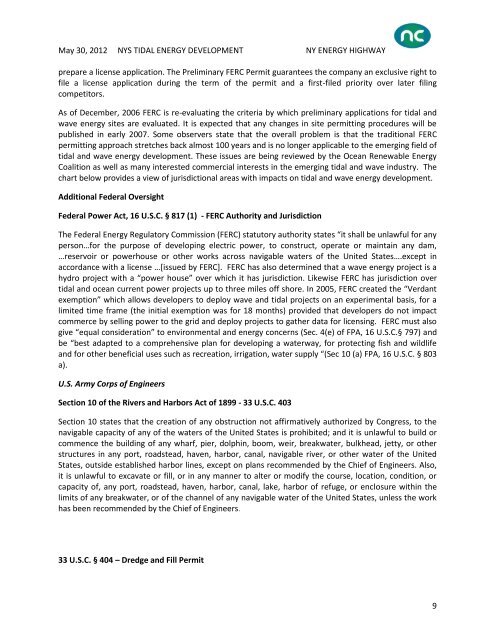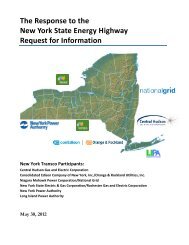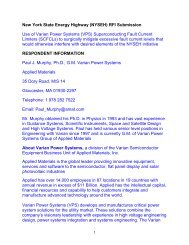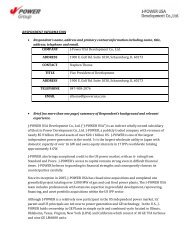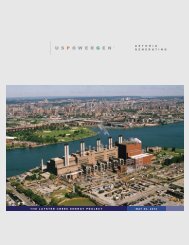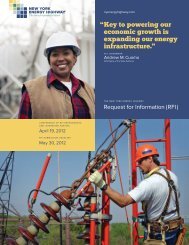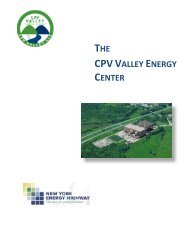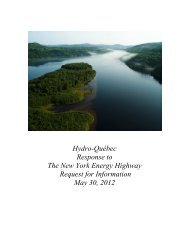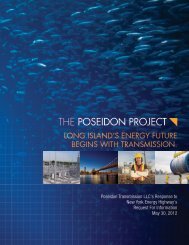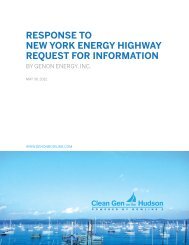Fishers Island Tidal Energy Project - Energy Highway
Fishers Island Tidal Energy Project - Energy Highway
Fishers Island Tidal Energy Project - Energy Highway
Create successful ePaper yourself
Turn your PDF publications into a flip-book with our unique Google optimized e-Paper software.
May 30, 2012 NYS TIDAL ENERGY DEVELOPMENT NY ENERGY HIGHWAY<br />
prepare a license application. The Preliminary FERC Permit guarantees the company an exclusive right to<br />
file a license application during the term of the permit and a first-filed priority over later filing<br />
competitors.<br />
As of December, 2006 FERC is re-evaluating the criteria by which preliminary applications for tidal and<br />
wave energy sites are evaluated. It is expected that any changes in site permitting procedures will be<br />
published in early 2007. Some observers state that the overall problem is that the traditional FERC<br />
permitting approach stretches back almost 100 years and is no longer applicable to the emerging field of<br />
tidal and wave energy development. These issues are being reviewed by the Ocean Renewable <strong>Energy</strong><br />
Coalition as well as many interested commercial interests in the emerging tidal and wave industry. The<br />
chart below provides a view of jurisdictional areas with impacts on tidal and wave energy development.<br />
Additional Federal Oversight<br />
Federal Power Act, 16 U.S.C. § 817 (1) - FERC Authority and Jurisdiction<br />
The Federal <strong>Energy</strong> Regulatory Commission (FERC) statutory authority states “it shall be unlawful for any<br />
person…for the purpose of developing electric power, to construct, operate or maintain any dam,<br />
…reservoir or powerhouse or other works across navigable waters of the United States….except in<br />
accordance with a license …*issued by FERC+. FERC has also determined that a wave energy project is a<br />
hydro project with a “power house” over which it has jurisdiction. Likewise FERC has jurisdiction over<br />
tidal and ocean current power projects up to three miles off shore. In 2005, FERC created the “Verdant<br />
exemption” which allows developers to deploy wave and tidal projects on an experimental basis, for a<br />
limited time frame (the initial exemption was for 18 months) provided that developers do not impact<br />
commerce by selling power to the grid and deploy projects to gather data for licensing. FERC must also<br />
give “equal consideration” to environmental and energy concerns (Sec. 4(e) of FPA, 16 U.S.C.§ 797) and<br />
be “best adapted to a comprehensive plan for developing a waterway, for protecting fish and wildlife<br />
and for other beneficial uses such as recreation, irrigation, water supply “(Sec 10 (a) FPA, 16 U.S.C. § 803<br />
a).<br />
U.S. Army Corps of Engineers<br />
Section 10 of the Rivers and Harbors Act of 1899 - 33 U.S.C. 403<br />
Section 10 states that the creation of any obstruction not affirmatively authorized by Congress, to the<br />
navigable capacity of any of the waters of the United States is prohibited; and it is unlawful to build or<br />
commence the building of any wharf, pier, dolphin, boom, weir, breakwater, bulkhead, jetty, or other<br />
structures in any port, roadstead, haven, harbor, canal, navigable river, or other water of the United<br />
States, outside established harbor lines, except on plans recommended by the Chief of Engineers. Also,<br />
it is unlawful to excavate or fill, or in any manner to alter or modify the course, location, condition, or<br />
capacity of, any port, roadstead, haven, harbor, canal, lake, harbor of refuge, or enclosure within the<br />
limits of any breakwater, or of the channel of any navigable water of the United States, unless the work<br />
has been recommended by the Chief of Engineers.<br />
33 U.S.C. § 404 – Dredge and Fill Permit<br />
9


